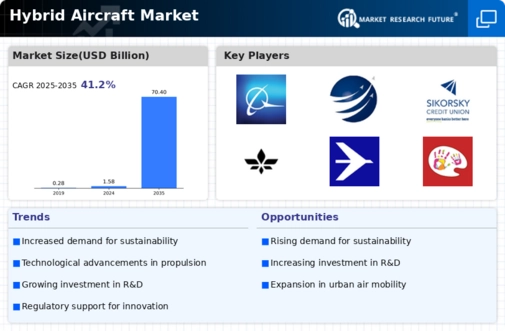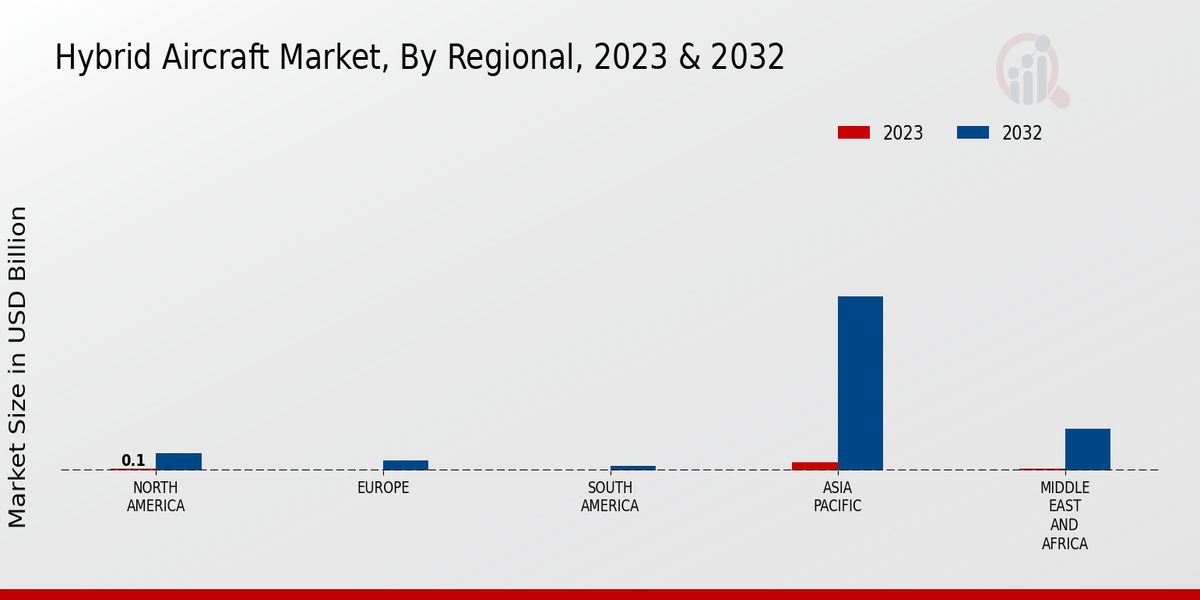Rising Fuel Prices
The volatility of fuel prices significantly impacts the Global Hybrid Aircraft Market Industry. As fuel costs continue to rise, airlines are increasingly seeking cost-effective solutions to maintain profitability. Hybrid aircraft, which utilize a combination of traditional fuel and electric power, present a viable alternative to conventional aircraft. This shift could lead to a reduction in operational costs, making hybrid models more attractive to airlines. The anticipated growth in the market, with a projected CAGR of 41.22% from 2025 to 2035, underscores the potential for hybrid aircraft to mitigate the financial pressures associated with rising fuel prices.
Environmental Regulations
Stringent environmental regulations are a driving force in the Global Hybrid Aircraft Market Industry. Governments worldwide are implementing policies aimed at reducing carbon emissions and promoting sustainable aviation practices. These regulations encourage manufacturers to develop hybrid aircraft that comply with new standards. For example, the European Union has set ambitious targets for reducing greenhouse gas emissions in aviation, which is likely to propel the demand for hybrid aircraft. As the market adapts to these regulations, it is expected to grow substantially, potentially reaching 70.4 USD Billion by 2035, reflecting a strong commitment to environmental sustainability.
Market Growth Projections
The Global Hybrid Aircraft Market Industry is poised for substantial growth, with projections indicating a market size of 1.58 USD Billion in 2024 and an anticipated increase to 70.4 USD Billion by 2035. This growth trajectory suggests a robust interest in hybrid technology, driven by factors such as technological advancements, environmental regulations, and rising fuel prices. The expected CAGR of 41.22% from 2025 to 2035 further emphasizes the potential for hybrid aircraft to transform the aviation landscape. These projections highlight the increasing recognition of hybrid aircraft as a viable solution for sustainable and efficient air travel.
Technological Advancements
The Global Hybrid Aircraft Market Industry is experiencing rapid technological advancements that enhance aircraft efficiency and reduce emissions. Innovations in battery technology and hybrid propulsion systems are pivotal in this evolution. For instance, the integration of electric motors with traditional engines allows for reduced fuel consumption and lower operational costs. As a result, the market is projected to reach 1.58 USD Billion in 2024, driven by these advancements. Companies are increasingly investing in research and development to create more efficient hybrid models, which could lead to a significant transformation in aviation practices globally.
Investment in Infrastructure
Investment in infrastructure is crucial for the growth of the Global Hybrid Aircraft Market Industry. The development of charging stations and maintenance facilities for hybrid aircraft is essential to support their operation. Governments and private entities are recognizing the need for such infrastructure to facilitate the transition to hybrid aviation. For instance, initiatives to establish electric charging networks at airports are underway, which could enhance the feasibility of hybrid aircraft operations. This investment is expected to stimulate market growth, as it addresses one of the key barriers to the widespread adoption of hybrid technology in aviation.
Increased Demand for Sustainable Aviation
There is a growing demand for sustainable aviation solutions within the Global Hybrid Aircraft Market Industry. Stakeholders, including airlines and passengers, are increasingly prioritizing eco-friendly travel options. Hybrid aircraft, which promise lower emissions and reduced noise pollution, align with these sustainability goals. This trend is reflected in the increasing number of airlines committing to sustainable practices, thereby driving the adoption of hybrid technology. As public awareness of environmental issues rises, the market is likely to expand, with projections indicating a significant increase in hybrid aircraft adoption over the next decade.
























